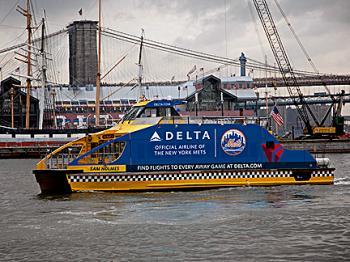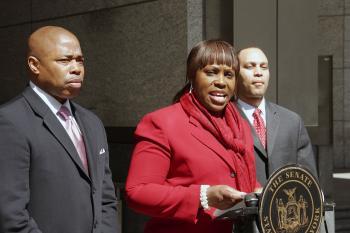NEW YORK—Hempstead Village on Long Island last week became the first New York local government to close its $12.5 million bank account with JPMorgan Chase Bank over the bank’s lending and foreclosure policies, which some say hurt communities.
On Thursday, the city’s Council Committee on Housing and Buildings, chaired by Councilman Erik Martin Dilan, held a public hearing to discuss three bills relating to the foreclosure of city properties.
Among those present to testify for or against the proposed legislations were business entrepreneurs, representatives from different organizations, and many individuals holding placards that read, “Hold Banks Accountable.”
“Many banks are refusing to seriously engage in the range of programs made available to help homeowners,” said Councilman Brad Lander.
The bills address concerns that relate to the maintenance of properties and buildings that are in foreclosure proceedings.
The legislations would ensure “banks step up and take responsibility for properties they are foreclosing on,” said Lander.
The number of foreclosures in the city has been rising steadily, according to a recent foreclosure in NYC report issued by the state comptroller’s office.
Queens topped the list with nearly 9,000 foreclosure filings, followed by 7,108 in Brooklyn, 3,000 in the Bronx, 2,646 on Staten Island, and 1,168 in Manhattan, stated the report.
The foreclosure crisis created much suffering for many families and communities, said Lander.
Nearly 30,000 homes are pending foreclosure in the five boroughs and many properties and families are in limbo due to the crisis, according to a press statement issued by New York Communities for Change.
Currently, the foreclosure process in the city takes around two years, stated both Michael Smith, president and chief executive officer of New York Bankers Association and Bruce Bergman, a mortgage attorney.
There had been 6,000 loan modifications applications made through the Center for NYC Neighborhoods and its affiliates and nearly 4,000 more pending. The waiting period for loan modification application could take up a year to approve.
The foreclosure crisis continues to have a big impact on property owners and “a distinct impact on distressed single family homes versus that of multifamily residences,” said Ruth Anne Visnauskas, deputy commissioner for the New York City Department of Housing Preservation and Development (HPD).
Both Intro No. 494 and 500 propose a requirement for lenders starting a foreclosure to bear all financial responsibility for building maintenance and code compliance.
The intention of the bills is to “ensure the buildings are maintained properly during the foreclosure action and that tenants are protected from potential neglect and physical distress,” said Visnauskas.
Intro No. 494 specifically stipulates a minimum of $10,000 compliance bond to reimburse HPD for the cost of any emergency repairs, fines, or civil penalties.
However, imposing a financial requirement not only deters lenders from foreclosing but also discourages lenders from offering mortgages in the first place, said Visnauskas.
“Policies which discourage banks from foreclosing have the potential to harm such properties and the tenants who live in them,” said Visnauskas.
The condition of buildings will thus deteriorate more because the owner, without any hope of recouping its investment, does not have the financial incentive to make repairs nor the ability to get money for these repairs.
Intros 494 and 500 raised several legal concerns. One is the question of whether the lender or mortgagee has the legal authority to enter the building, or make any housing repairs.
Under the current law, the owner is obliged to maintain and make repairs while the lender has no such legal authority unless the mortgage explicitly authorizes it to do so.
“The bills raised a doubt as to the owner’s continued responsibility if the maintenance obligation is imposed on the lender,” said Visnauskas.
Likewise, both Smith and Bergman also pointed out the legal concerns of the legislations.
The term “residential property” is “truly unclear” and open to legal misinterpretations, said Bergman.
The legislations raised concerns including violation of the privacy of affected homeowners and potential security risks on homeowners and lenders.
The requirement may involve “mortgagees to breach their privacy obligations to their customers,” said Smith.
The maintenance requirements called for mortgagees to maintain and even repair damages sometimes caused by irresponsible landlords.
“The financial burden of maintaining properties not owned by the lenders will therefore, inappropriately, and without legal authority, be shifted from the property owner to the lender, at unknown but potentially significant cost and administrative burden to the mortgagee,” said Smith.
On Thursday, the city’s Council Committee on Housing and Buildings, chaired by Councilman Erik Martin Dilan, held a public hearing to discuss three bills relating to the foreclosure of city properties.
Among those present to testify for or against the proposed legislations were business entrepreneurs, representatives from different organizations, and many individuals holding placards that read, “Hold Banks Accountable.”
“Many banks are refusing to seriously engage in the range of programs made available to help homeowners,” said Councilman Brad Lander.
The bills address concerns that relate to the maintenance of properties and buildings that are in foreclosure proceedings.
The legislations would ensure “banks step up and take responsibility for properties they are foreclosing on,” said Lander.
The number of foreclosures in the city has been rising steadily, according to a recent foreclosure in NYC report issued by the state comptroller’s office.
Queens topped the list with nearly 9,000 foreclosure filings, followed by 7,108 in Brooklyn, 3,000 in the Bronx, 2,646 on Staten Island, and 1,168 in Manhattan, stated the report.
The foreclosure crisis created much suffering for many families and communities, said Lander.
Nearly 30,000 homes are pending foreclosure in the five boroughs and many properties and families are in limbo due to the crisis, according to a press statement issued by New York Communities for Change.
Currently, the foreclosure process in the city takes around two years, stated both Michael Smith, president and chief executive officer of New York Bankers Association and Bruce Bergman, a mortgage attorney.
There had been 6,000 loan modifications applications made through the Center for NYC Neighborhoods and its affiliates and nearly 4,000 more pending. The waiting period for loan modification application could take up a year to approve.
The foreclosure crisis continues to have a big impact on property owners and “a distinct impact on distressed single family homes versus that of multifamily residences,” said Ruth Anne Visnauskas, deputy commissioner for the New York City Department of Housing Preservation and Development (HPD).
Both Intro No. 494 and 500 propose a requirement for lenders starting a foreclosure to bear all financial responsibility for building maintenance and code compliance.
The intention of the bills is to “ensure the buildings are maintained properly during the foreclosure action and that tenants are protected from potential neglect and physical distress,” said Visnauskas.
Intro No. 494 specifically stipulates a minimum of $10,000 compliance bond to reimburse HPD for the cost of any emergency repairs, fines, or civil penalties.
However, imposing a financial requirement not only deters lenders from foreclosing but also discourages lenders from offering mortgages in the first place, said Visnauskas.
“Policies which discourage banks from foreclosing have the potential to harm such properties and the tenants who live in them,” said Visnauskas.
The condition of buildings will thus deteriorate more because the owner, without any hope of recouping its investment, does not have the financial incentive to make repairs nor the ability to get money for these repairs.
Intros 494 and 500 raised several legal concerns. One is the question of whether the lender or mortgagee has the legal authority to enter the building, or make any housing repairs.
Under the current law, the owner is obliged to maintain and make repairs while the lender has no such legal authority unless the mortgage explicitly authorizes it to do so.
“The bills raised a doubt as to the owner’s continued responsibility if the maintenance obligation is imposed on the lender,” said Visnauskas.
Likewise, both Smith and Bergman also pointed out the legal concerns of the legislations.
The term “residential property” is “truly unclear” and open to legal misinterpretations, said Bergman.
The legislations raised concerns including violation of the privacy of affected homeowners and potential security risks on homeowners and lenders.
The requirement may involve “mortgagees to breach their privacy obligations to their customers,” said Smith.
The maintenance requirements called for mortgagees to maintain and even repair damages sometimes caused by irresponsible landlords.
“The financial burden of maintaining properties not owned by the lenders will therefore, inappropriately, and without legal authority, be shifted from the property owner to the lender, at unknown but potentially significant cost and administrative burden to the mortgagee,” said Smith.






